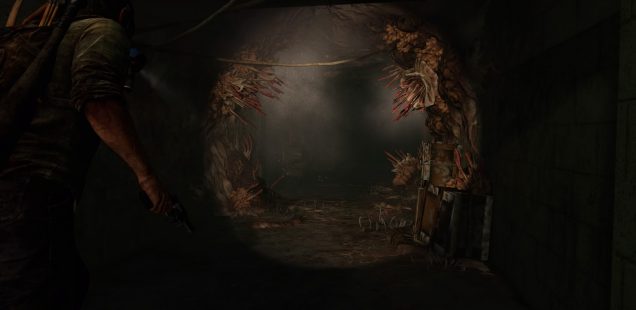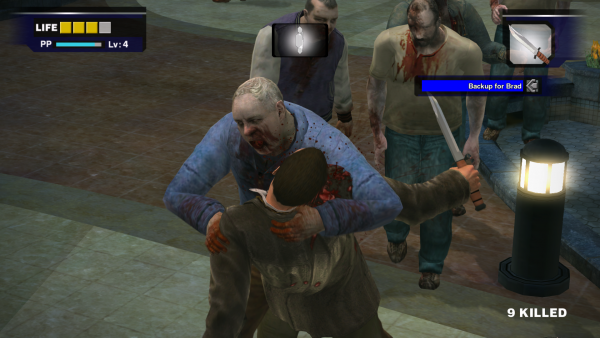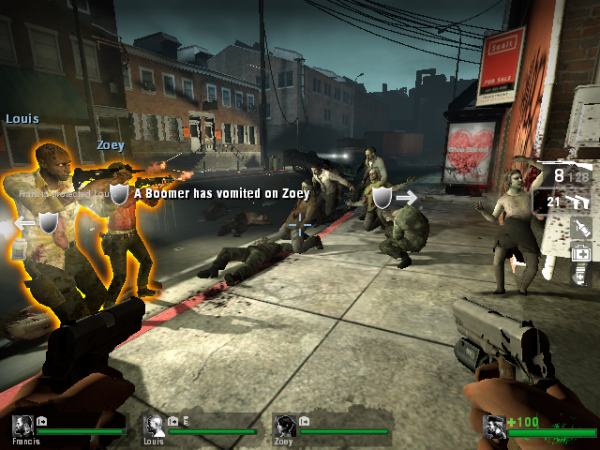
Immune, Superior Protagonists in Zombie Videogames
B.G.M. Muggeridge puts zombie game protagonists under the microscope.
The visual and auditory differences in the undead enemies of zombie videogames allow players easy stereotyping, making obvious where the player should direct their violence. But that is only one part of the equation. In order to fully appreciate how viruses operate in videogame environments, we must also examine how they affect, or do not affect, the protagonist. Players rarely exist as zombies within zombie games. As infected are shown to possess little autonomy, it would arguably be a dull, uninteresting gameplay experience to shamble around, only to be riddled with bullets by the first person towards which you move. Instead, the idea of the immune protagonist dominates.
Cultural depictions of zombies vary regarding the origin of the creatures themselves. Viral infection is the most prominent way in which zombification spreads, by being bitten, ingesting bodily fluids, or breathing in a pathogen. But each and every protagonist transcends this mortal inconvenience. Despite the virus representing a catastrophic danger to the future of human civilisation, our protagonists can operate unfazed even as zombies bite them, cover them with blood and bile, and release spores into the air. Even one bite can turn most people, but protagonists can experience multiple bites before death. Many terms exist to define the ‘plot armour’ many protagonists possess, yet there is a unique quality to the resistance given to player-characters that operate in worlds of infection, hence the immune protagonist. I will examine this tendency in three main ways: highlighting how the protagonist is presented as a superior being, analysing how personal and environmental hygiene factors in this creation, and finally offering a critique of the design and ideology of zombie games given these bases.
Superiority
The wider critique here is about videogame protagonists in general; their perceived natural superiority limits the effective moral and ethical questions at the level of text. Many academics have suggested the unique ways in which players relate to the player-character. We can think of player characters as puppets, empty objects controlled by the player without their own autonomy. The most interesting description is that of a prosthesis, a natural extension of the human body that facilitates their movement in a digital space. There are also more symbolic connotations, such as the classical idea of the player acting as a god-like figure, guiding the actions of a hero through an epic narrative. Each have interesting effects on how we view the player-character relationship, but none really speak to the question of how a player-character’s actions exist within ethical structures of the game world itself, and by extension the function they serve in narrative. Immunity makes sense if the player-character is a tool or prosthesis, but this causes tension with narrative consistency in the diegetic reality of viruses in videogames themselves. Our question becomes: why can protagonists act in ways without being subject to the limitations of other characters?
Left 4 Dead addresses this issue head on. The protagonists discover they are in fact not immune to the virus but are instead asymptomatic carriers of the disease, explaining their repeated failure to escape as they infect anyone that tries to rescue them. Could the text be asking us to consider how these survivors seem only capable of condemning everyone around them to death? Why is this ethical question more significant, in that a ‘healthy’ human is being infected by them, than the question of why it’s permissible to gun down armies of infected human beings? The protagonists are metaphors for the archetypal videogame hero, whose path is littered with bodies as they seem to bring turbulence with them. In fact, one could argue this makes the protagonists themselves a more effective viral threat than the virus itself, responsible for far more death than any zombie is.
Resident Evil has this issue as well. Chris and Jill, the protagonists, can be bitten by the infected and brush it off with a simple ‘First Aid Spray.’ There is no canonical vaccine they have taken, yet they are entirely resistant to the infection. Whilst the gameplay does not facilitate the sort of mass violence of Left 4 Dead, there are features to the gameplay design of Resident Evil which emphasise the player-characters’ autonomy, such as the puzzles and the transitions between corridors and rooms. The player’s ability to traverse the mansion and solve its puzzles is what distinguishes them from the zombies. The player’s movement becomes a power in itself and one that marks the player-character as superior.
The immunity of Ellie is the primary motivating subject for The Last of Us, as Joel is tasked with protecting Ellie due to her natural immunity. Joel’s personal involvement as a father figure extends this, acting as the physical manifestation of violence needed to protect her, as well as being granted a meta-immunity by the player’s need for an engaging gameplay experience. It seems somewhat laughable that Joel can strangle infected people to death with his bare hands, immediately remove his face mask once visible spores have disappeared and never once seem to wash his clothes, whilst remaining uninfected. Yes, gameplay reasons are a perfectly valid explanation for this, but this itself exposes why game design reinforces certain assumptions about protagonists in infected worlds; they are simply better than everyone else.
Frank West’s superiority in Dead Rising is molded by his capacities to perform a kind of creative consumption. He leads other survivors through the shopping mall and dispatches huge numbers of zombies in the process, as well as so-called ‘psychopaths’; hostile survivors driven mad by their situation. Frank’s abilities also function narratively, as he is the only person capable of investigating the source of the virus. Creative use of the objects and environment marks Frank as superior, an overt reversal of the zombies’ inability to freely traverse the mall and single-minded capacity to consume flesh. Other NPCs are reliant on him for their survival, incapable of defending themselves or finding safety.
The notion of superiority is itself inherent to videogames as a medium. The players who possess more natural skill with controllers are always at an advantage compared to those with lower natural aptitude and less frequent players. They are more likely to be able to navigate new environments equipped with a set of assumptions about gameplay and NPCs behaviour. This bias may seem irrelevant, but it possesses a great deal of power in game design. Dark Souls is the obvious example. The difficulty is a diegetic feature, yet affects how players treat one another outside of the gameplay experience itself. FromSoftware games in general find themselves in an unsavoury cultural space that struggles with the idea of diegetic difficulty and changeable difficulty, pitching ‘hardcore’ gamers against ‘casuals.’ This is an explication of the inherent ideological problem of the videogame protagonist. Those who are less capable are considered valid targets for hostility, manifested as mortal violence within videogames themselves. Individualism dominates, yet often fails to appreciate how vulnerability matters. Players can die and respawn with little consequence, depending on the genre, which limits games that feature viral outbreaks in terms of questions of personal safety.

Hygiene
Making protagonists above the material conditions of viruses also externalises danger to those who challenge the player’s progress. Yet the primary danger in infected environments should really be the virus itself. Viruses exist as physical things in the world, and our interactions with them is what determines our infection and mortality rates. In fact, the design expectations of videogames seem to demand the inverse: that players should physically see the bodily fluids painted upon their protagonists to add authenticity to their violence. Blood and bile covering player-characters is expected in visual design, but what is not highlighted is the subsequent requirement to completely clean and sterilise lest the player themselves become infected. Selective realism is fundamental to almost all entertainment media, but for games that use viruses as the primary narrative motivator, the omission of such cleaning mechanics feels stark.
Agency is what matters; who has control over the transmission of a virus? As we are participants in the narrative, we feel, as players, as if we are the ones in control of our environment. We may alter our behaviour and manoeuvre accordingly, but we are the ones determining the outcome of events. Enemies are programmed to behave in certain ways, but players are free to act creatively within the game space. Note this is how players are encouraged to feel, rather than an accurate description of the gameplay process; developers construct environments for us and are specifically limited, not free. Yet epidemiological matters would reverse this sense of agency, as the ‘triad’ of factors makes the disease the ‘agent.’ Humans are relegated to the role of ‘host,’ conditionally infected by their presence in the ‘environment. Videogames are therefore at odds with how epidemiology functions in that the player is made agent over all other programmed functions.
In real-world viral transmission, hosts may not necessarily get sick, but the fictional threat of the zombie is far higher than any real infection. Personal hygiene as a means to prevent zombification would therefore be far higher than its already primary importance in realistic pandemics. We can start to piece together a larger critique, governed by the demand for players to feel powerful as well as the selective desire for realism, immersing us in real worlds whilst providing us with the tools to be exceptional within it. Violence is the easiest way to stage this conflict, physically dominating those who are given neither autonomy nor agency. Yet the conflict inherent with a viral outbreak should instead use the virus itself as the incitement to action. Personifying a virus in the form of the zombie is therefore far more conservative in its approach to game design that it might appear. Why should a player be encouraged to use their privileged resistance to a virus as an accessory to a violent behaviour, rather than question the ethics of this violence, as well as questioning what that resistance even means?

Design & Ideology
The common thread for these protagonists is that they are people who are not subject to the effects of a mind-destroying virus and must attempt to survive as hordes of infected swarm upon them. This requires a violent response in kind, but given the dense ideological assumptions made in the construction of zombies as objects, the problem becomes more complex. Human zombies are not natural; they do not exist. Therefore, the way in which the gameplay is designed exposes the anxiety many people suffer when considering large anonymous blocks of people, particularly in opposition to those considered dominant. A perfect parallel is found with postcolonial criticism of media. For example, in Cy Endfield’s 1964 film Zulu, we see a valiant band of Welsh-British soldiers defend a small encampment from the Zulu army. The film presents this as a heroic endeavour, as the larger force staffed by anonymous Black African Zulu warriors wears down the White soldiers, and foregrounded Officers, whose resistance is the main narrative thread. Why choose the British soldiers as the heroes? Phil Morris quite neatly summarises how, ‘the presence of the Zulus serves only to contextualise the bravery of their Welsh enemy.’
Colonial Britain was not a benign force. Indeed, the Zulu resistance to Imperial occupation should arguably be considered the heroic perspective, yet the ideological assumptions made by the writers and filmmakers mean the White characters have more autonomy and personality than the Black characters. Left 4 Dead is a parallel, as the anonymised zombie horde throws itself against the valiant team of survivors, their own need to survive overruling any moral qualm of committing mass murder. In fact, all these games demonstrate variable degrees of this dynamic. The dehumanised, racialised ‘hordes’ are the main aggressor, and the protagonist is able to present an image of heroism in their violent response. But the aggressors are not neutral objects outside of our ideological narrative constructs, instead forming an image of the racialised Other. Colonialism predicated itself on a ‘civilising mission’ justifying its use of violence against native populations on the grounds it was a necessary evil to create them as civilised countries. The people were dehumanised, their languages erased and their very humanity constructed as lesser by scientific racism. Ultimately, the violence of aggressive colonialism was thus reframed as a sort of ‘defensive’ act, protecting colonial values against the supposedly ignorant natives who denied their civilising mission. Left 4 Dead’s practice of establishing a genetically privileged few as justified in enacting mass violence against hordes of dehumanised, inarticulate monsters seems to build on this legacy. The experiences of the people turned to zombies are irrelevant, and the need for the protagonists to survive overrules moral and ethical questions about killing infected people. Their physical vulnerability is heightened just as the player-character’s physical resistance is.
Immunity therefore is more than just a factor in enhancing the player’s enjoyability of an experience, it instead speaks to a hyper-traditional view of heroes and protagonists, unfazed by the mortality and fragility of the Other. By removing a character’s vulnerability to the material world of the game, we are encouraged to belittle the struggles and realities of those deemed lesser, undermining the potential for a pure experience of empathy and a genuinely ethical experience. This is a valid design choice, but one that cannot be separated from wider social systems of oppression and dehumanisation.

Conclusion
An action item, then, for game developers would be to create a gameplay experience in which the player is encouraged to think less about the direction of their violence, but the direction of environmental danger as it moves around them. If zombies are considered disease transmission vectors rather than hyper-violent targets, we reframe the problem two-fold. The player is no longer assumed to want to kill zombies as a first response, providing an interesting ethical experience should the designer choose to pose one. If the player has learnt to avoid them and maintain their personal space, could the game provide them with a way of killing zombies in order to see how players respond? This would be an intensely ethical approach to game design. The second solution is forcing players to feel vulnerable at the level of the pathogen rather than simply the personified image of it. Players could be encouraged to explore environments in increasingly careful ways, even encouraging them to prioritise items of personal hygiene over murder.
As mentioned at the start, interpreting the immune protagonist in these few games, as well as the focus on questions of dehumanisation and immunity, only addresses the issue of viral depiction in part. I have not yet touched upon arguably the most important and unique element of viral infection in gameplay, namely: how the virus exists in the physical space of the game. By now, readers will have noticed how dehumanisation of the zombie and superiority of the protagonist fit into wider political questions. Immigration, refugees, borders and space-management are the underlying forces that guide our experience of movement within infected worlds. In a final piece to come, I will be explaining this unique combination of factors in a discussion about the politics of space.
B.G.M. Muggeridge is a freelance games and politics writer. He is a research graduate of Cultural Studies from the University of Nottingham, where he specialized in the construction of complicity in videogame design.